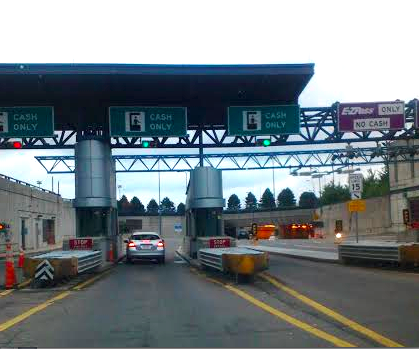What to expect with all-electronic tolling
This blog is a summary of the changes an all-electronic tolling system will bring to the state. For a more in-depth look at this topic, please read the full length report, Driving Innovation: Tolling and Transponders in Massachusetts.
This fall the Massachusetts Turnpike will transition to an all-electronic tolling system (AETS), meaning drivers will not have to stop or slow down to pay tolls. Massachusetts Department of Transportation (MassDOT) officials say that an AETS will yield cost savings, reduce accidents and pollution, and save drivers time.
Toll booths along the Turnpike will be removed, and new gantries (under construction for the last few months) equipped with sensors and cameras will take over from toll-takers. All drivers will remain at normal driving speeds as they pass under the gantries. Cars with E-ZPass transponders will automatically have the charge deducted from their tolling balance, while cars without a transponder will have their license plate photographed and receive a monthly bill in the mail.
By eliminating toll plazas, the state reduces the number of merges and bottlenecks on the Turnpike, making the roads safer for drivers. Both toll workers and Turnpike drivers have been involved in fatal accidents near toll booths over the past few years. Plaza removal also means quicker drive times and reduced emissions for everybody on the Turnpike.
The state will save money by eliminating toll-taker jobs, instead centralizing its day-to-day tolling operations at a Customer Service Center (CSC) operated by TransCore as part of its $201.6 million contract. While E-ZPass transponder transactions are easily processed, drivers without transponders must have their license plate photographs checked by image review clerks as part of the Pay-by-Plate (PBP) system. This creates a relatively costly extra step that is compounded by the expense of mass mailings and tolls that may never be collected due to delinquency. Failure to pay a PBP charge results in minor fines every 30 days and a possible license suspension after 90 days.
Across the Turnpike and the state’s other tolled infrastructure, E-ZPass transponders are used for about 80 percent of transactions. Because of the increased costs of the PBP program relative to using a transponder, it is in the state’s best interest to maximize transponder usage. The state will continue to give out transponders for free, and they will be available at CSC’s, via online or phone requests, and at participating RMV locations, AAA branches, and Herb Chamber’s dealerships. Tolling account balances can be managed using cash at one of over 250 retail locations or a CSC; by check; or using a credit card over the phone or online.
The charge for driving from one end of the Turnpike to the other will remain the same. Drivers who currently use an E-ZPass transponder receive a $0.50 discount to reflect the reduced administrative costs, and this will continue with the AETS system. The gantries will be spread out more evenly than the toll booths were, and the state is still determining charges for driving shorter distances on the Turnpike.
A common concern among the minority of drivers who prefer not to utilize an E-ZPass transponder is maintaining personal privacy. In addition to the Federal Driver Privacy Protection Act, Section 13 of Chapter 25 of the Massachusetts Legislative Acts of 2009 forbids travel and transaction data from transponders to be used outside the scope of tolling and warranted law enforcement investigations. Additionally, MassDOT does not require the user to link their transponder to a credit card, instead allowing transponders to be refilled using cash at various retail locations throughout the state.
Starting this fall commuters can expect to see more changes along the Turnpike, beginning with completion of the gantries and ending with removal of the toll booths. Although there may be concerns regarding privacy, late fees and toll dodgers, the smoother flow of traffic and reduced congestion are sure to placate most of the Bay State’s drivers and visitors. That the state will be saving money is MassDOT’s stated secondary goal. Instead, the point of implementing an AETS “is customer convenience and its safety, congestion and emission-reduction benefits.”
This blog is a summary of the changes an all-electronic tolling system will bring to the state. For a more in-depth look at this topic, please read the full length report, Driving Innovation: Tolling and Transponders in Massachusetts.
Scott Haller is a Research Assistant who began working at Pioneer Institute through Northeastern University’s Co-op Program.



